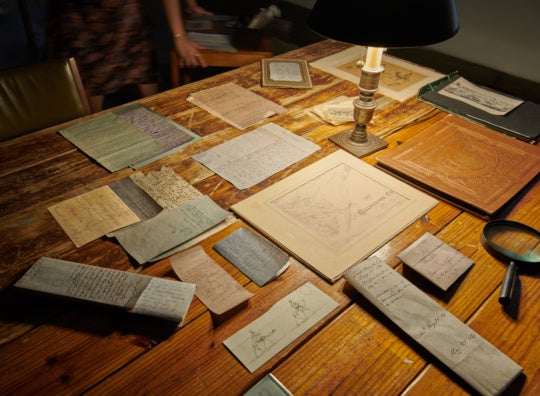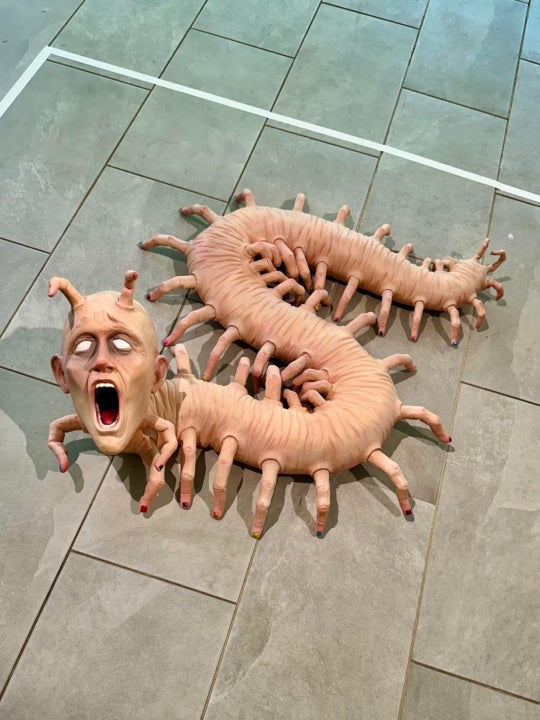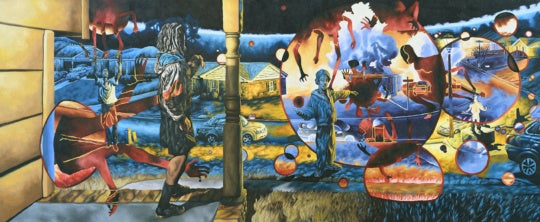
Budd Dees is a maker working in real and virtual spaces as a sculptor, writer, and digital artist. He currently divides his time between Georgia and Florida, where he teaches, creates, freelances, and washes dishes. He loves cats, distrusts experts, and his boyfriend lets him sing the boy parts on the B-52s “Song for a Future Generation” (because he really does want to be the nicest guy on Earth). Budd and I met at the Atlantic Center for the Arts in New Smyrna Beach, Florida, this past winter, where we studied with master artist Dana Schutz and her husband, sculptor Ryan Johnson. While there, I had the chance to interview Budd about his current and upcoming projects, his comfort in failures, and his sincerity of awkwardness.
Shara Hughes: What are you making at the residency?
Budd Dees: I started making these forms for an installation in our very small bedrooms here. They are going to be objects of discomfort, things that alter the way you use the bedroom. One is a rug that is on one side of the bed, that forces you to get out of the bed when you wake up. But now I realize they are not going to be finished by the time we leave, so I started thinking of them more as abstractions. I’m learning a lot from the painters.
SH: What kind of materials are you working with?
BD: I’m working with papier-mâché right now. I also work with digital tools and 3-D modeling, but here it seems easier and more about the community to be in the studio buildings with all the other painters.
SH: Because you won’t be able to install the works in your room, are you going to use the objects now as something about discomfort in a specific space?
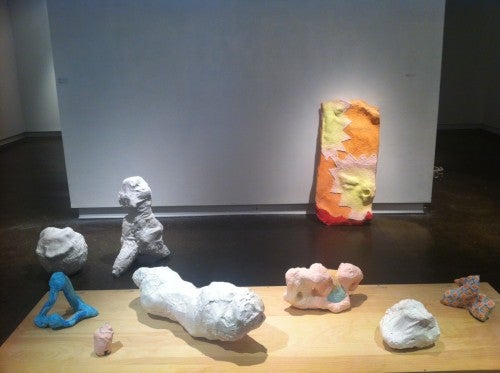
BD: I don’t know. I think it was something I used in the beginning to figure out the shape, but now I’m not sure. Maybe it will be something that will come back into the title as a way to figure out how to contextualize the object. Is this rug still an object of discomfort, or is it like a volcano rock formation, or an artifact?
SH: Your color choices are a light pastel palate. For me, they have this nostalgic feeling of childhood. I see something comforting in the color but, on the other hand, uncomfortable in the forms. Does this have something to do with your color choices?
BD: Yeah. I mean, the color choices are restricted to the paper choices at Office Max [laughs], so that’s what I use. But I think they come out as very friendly and approachable colors. For a long time, I was trying to think about how make these sculptures that were incredibly friendly and approachable, and something that my mom could come to the gallery and be like “oh … this is nice.” That maybe makes the more difficult conversations easier to talk about. Like, maybe loneliness is weird and a hard thing to talk about, but if it’s colorful, then maybe it’s more like “oh, i can deal with that.” Dana [Schutz] was saying there’s something unsettling about their shape and the sickness of the sculpted, clumped paper, but there’s something appealing about the color that’s really okay.
SH: You can also see so much of your hand in the work, that it gives you something that is relatable. In this way, it reads as something tangible although it’s uncomfortable at the same time.
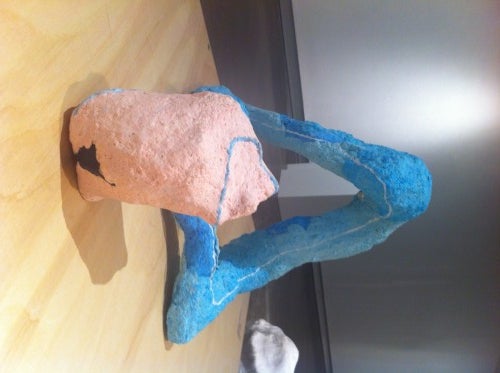
BD: They are very subjective, and I think the craft element makes them not so authoritarian. They don’t try to dictate how you see something, and they don’t try and make you feel something in a certain way.
SH: So are these objects intended for someone to live with?
BD: Yes, I’ve been thinking they should be put in contingencies, or put them in places they can grow or live. I’ve also been thinking of how I would perform with them. So, for example Franz West used those Adaptives, the objects people performed with in his videos. I don’t know if that seems like too active of a way to use the sculptures; I’m more of a wallflower-type person, so I’m not sure if that’s the route for me. But I’ve been thinking of maybe doing a performance in my room or somewhere private and then altering the way I use them, letting them be the active thing, and I’m the more passive thing.
SH: Right. Almost as if you have to squeeze by something in a hallway, or maybe your movement in the room is different because of the objects being there in a disruptive way.
BD: Right. The sculptures are about some sort of awkwardness in that way.
SH: You do that really well. So how has this experience at the Atlantic Center for the Arts changed your work? You aren’t primarily a painter, and yet you’re working around painters and have a very well-known painter [Dana Schutz] as your mentor?
BD: I’ve been able to think more loosely about what I’m doing, so it’s easy to let go of notions about what a sculpture can be or do. I’ve loosened up on the idea that these pieces have to go in the specific room I’m staying in while I’m here and thinking in a more painterly way, like “I made this mark on paper, and now the next step is how to react to that mark,” so it’s more reactionary … you guys [painters] are like workhorses. There’s a definite pleasure of working that I can get reacquainted with. So, I can have the pleasure of working while I’m here, and then two weeks later, when we are out of here, I can figure out what it all means.
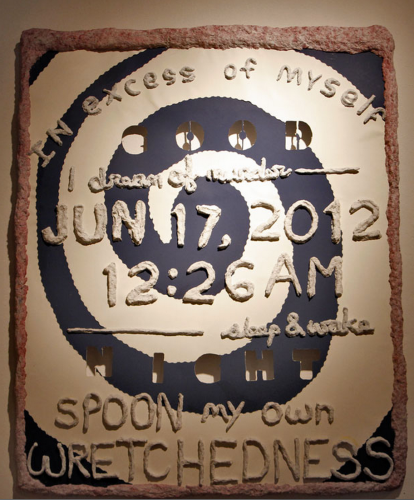
SH: What was it that appealed to you about Dana and her work when you applied?
BD: I actually wasn’t that familiar with Dana and her work when I applied, but when I got accepted I got really excited looking at images of her work. I think she’s made a project of the process of working as an artist. That’s something I’m interested in. Like, one of my sculptures broke, and I had to rethink how to fix it. I had to work through a new problem. She’s super interested in these processes. These failures happen, and you have to deal with them. Also, she talks about how we went through a time when paintings were objects and sculptures were objects, so it was very important to know that these things were just illusions. However, on more than one occasion she has un-ironically said, “OK, it’s an illusion, but we can still exist in this imaginary space and suspend the disbelief for just a minute.” Which I like.
SH: Dana’s husband, Ryan Johnson, who is also a great sculptor, has been here with us at ACA. How has it been to work with him?
BD: He’s amazing. He’s very interested in very different things, and things that are slick and slender, which is something I’ve been thinking about because my work is very clunky. I’ve been thinking that maybe I need an elegant leg to come off this clunky shape.
SH: Yeah, but I feel like that’s why yours are so charming: because it’s your vision, and not someone else’s idea of how to make it look better.
BD: For sure. But it’s been nice to think that my work doesn’t just have to be a block of paper. It can do other things. Ryan has helped me come to the realization that it can be a block but have another element.
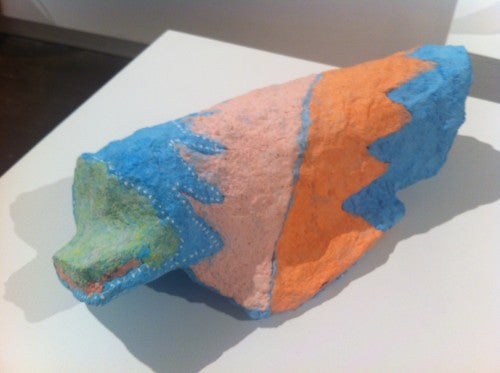
SH: How do your video pieces factor in your vision?
BD: There is still something awkward and quiet that connects the work. I think the videos are more witty than the sculptures. However, there’s the same challenge of how to balance something that’s sad, serious, and maybe even has a feeling of being juvenile, with some sort of charm and sincerity.
SH: Tell me about the screen saver video.
BD: The video is a dance to a Nina Simone song and the screen saver is that starry night background that comes with Mac computers. The dance is the cursor moving around the screen. I think it’s a nice metaphor to dancing with the night sky, like some sort of commiseration with the heavens, that the screen saver starry night sky understands this thing inside you—so it turns into this big joke. I thought it would be nice to take it seriously with something like a desktop, which is so like stupid and banal.
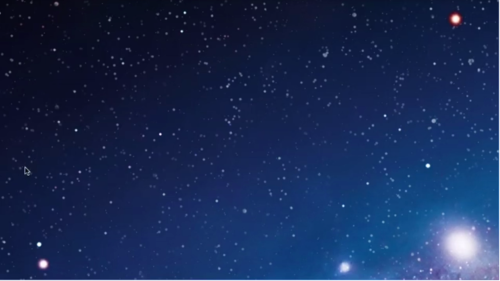
SH: Yeah, I think it’s very funny because of the length of time of the song. Once it starts, it’s so funny, but then it goes on for an almost awkward amount of time, where you’re like, “wait … is this a little bit sad?” Then you start daydreaming about a lost love and you’re kind of lost in the stars like the dancing cursor. And then, after another minute or so goes by, you realize you just daydreamed to a dancing cursor and screensaver for a good four minutes, and you get a little embarrassed in a sentimental way.
BD: [Laughs] Yeah, when I was choreographing it and rehearsing, I almost forgot that the mouse can click, and so then I started to click the mouse at the end, and it lets you draw shapes on the desktop.
SH: To me it felt as if it was the climax of the piece and maybe those were fireworks that was the highlight or end of the piece.
BD: Exactly!
SH: Do you have an overall arching theme within all the work you make from sculptures to videos and performance?
BD: Yes, well, like how does someone be sincere? How can you make a joke about sincerity, or how do you escape the trap of making a joke about sincerity without being ironic? I’m interested in that edge that the pieces walk. I find that awkwardness, failure, and discomfort have become the best way for me to insinuate I’m being honest.
“The Usual Mating Habits of Matter and Ground,” a collaboration between Budd Dees and Galen Olmstead, is on view May 15- July 31 at the Welch School Galleries at Georgia State University. Dees is also in a four-person show titled “PRELIMINARY STUDY: RSI – T” at Slag Gallery in Bushwick, Brooklyn, on view May 16-June 10. Shara Hughes is an Atlanta artist and writer for Burnaway.


